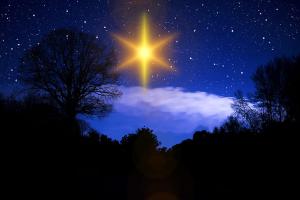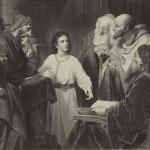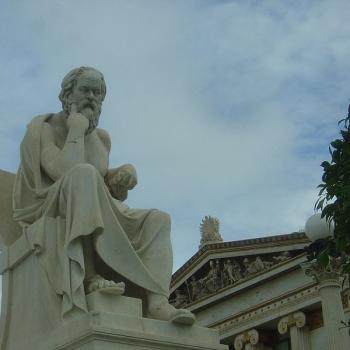Atheist and anti-theist Bob Seidensticker runs the influential Cross Examined blog. I have critiqued 84 of his articles (no counter-reply as of yet). He was gracious enough to send me a free e-book copy of his new volume, 2-Minute Christianity: 50 Big Ideas Every Christian Should Understand (May 2022), which I critiqued point-by-point. His words will be in blue.
*****
See my previous replies in this series (Part 1 / Part 2)
This is a reply to Bob’s articles, “Critique of ‘The Star of Bethlehem’ video” (12-9-22) and “Jupiter, Venus, Regulus, and Revelation: the fireworks of a real Star of Bethlehem?” (12-12-22).
[subtitle] It’s time to address the illogic in this biased video
Yeah; I’ll return the favor and address the illogic in Bob’s critique! Goose and gander! Isn’t dialogue wonderful?
it’s time for some tough love. Are you anxious for a takedown of Rick Larson’s The Star of Bethlehem video? I certainly am. Now that we’ve let the Christian side state their case (part 1 here), it’s time to respond. If you’ve been biting your tongue with rebuttals, let’s turn the tables. This’ll be fun.
And are atheists excited to interact with Christian defenses of the star of Bethlehem, where we turn the tables? I’ve yet to see it (and I’ve tried, believe me), apart from a few limited interactions with a few civil atheists. I think it’s a fun and educational discussion that we can have. It’s an extremely interesting topic (especially the more one learns about it).
That video argued that the conjunctions of Jupiter with Regulus and Venus during the years 3 and 2 BCE explain the story of the magi following the star in Matthew chapter 2. Volumes have been written with many other attempts to explain the star, but this video is a popular explanation, and I will use it as a representation of the field.
I mostly agree with the reasoning in this video, but not necessarily with everything. I’m not defending it per se, but offering my own (similar) opinions, arrived at after much research.
The video makes a clever and intriguing argument, but an intriguing argument doesn’t carry the day.
That’s right.
it may not be that remarkable to weave an interesting argument when you’re not following evidence but selecting it to pave a path to a conclusion you’re determined to reach.
I agree again. I just think that atheists are no more immune to this shortcoming than anyone else. We all have biases, and they often determine the conclusions we reach, almost before we reach them. That being the case, we can only make our arguments and let observers decide which one is more plausible or believable. I interact with opposing positions, as a socratic in methodology. And those who make those arguments can decide whether they want to interact with my reasoning.
Larson knows that he wants to find celestial fireworks at the time of the birth of Jesus to map onto Matthew’s Bethlehem star story, so he sifts and hammers the data to reach that conclusion.
That would be fundamentally dishonest. I don’t believe Larson was intending to be dishonest, anymore than I am. We simply have an opinion different from Bob’s, and provide scientific and historical arguments in favor of our own positions. It’s not a given that someone is a dishonest special pleader or a sophist, simply because they disagree with us.
The New Testament contains two nativity stories, but Larson, without apology, doesn’t bother to reconcile them.
He doesn’t have to. They’re not contradictory, and the goal of the video is to provide a theory about the star, not a comprehensive commentary on the two Nativity stories. This is an unreasonable and absurd demand.
He ignores Luke and focuses on Matthew.
He does so precisely because that’s where the star is mentioned! DUH! It’s like saying, “Bob ignored Newton and focused on Einstein, when discussing space-time and relativity.” What in the world is wrong with that? Nothing! Yet Bob makes out that somehow this is an unsavory method, for anyone to focus on the Gospel that refers to the star. When one is seriously hostile to a position, it adversely affects their reasoning ability, lessens their objectivity, and works against logically coherent and compelling arguments.
And like the zombies stumbling through the streets of Jerusalem in Matthew 27:52–3,
Attempt to ridicule and mock Matthew’s Gospel; in other words, to “poison the well” . . .
we’re left to wonder why the star and magi are also only in Matthew. If it was important enough for Matthew and it actually happened, why wasn’t it reported in the other gospels?
I would say, “I don’t know” but also (with equal vigor), “who cares?” There could be one reason or a dozen reasons. All we can do is analyze what we have. But clearly, none of the Gospel writers were under some supposed “obligation” to make sure they wrote about every jot and tittle that the other three Gospel writers dealt with. It’s ludicrous and unrealistic to posit such a “demand.” Moreover, what would be the point of having four virtually identical Gospels? That’s boring as sin. Most objective observers would note that the (non-contradictory, logically complementary) differences in the Gospels are a strong indication that they are genuine, and not some grand joint conspiracy of mythmaking: just as multiple witnesses in court trials invariably differ on emphases and details.
Matthew’s nativity account says that Jesus was born before King Herod died. 4 BCE is the traditional date of Herod’s death, but this prevents Larson from using the celestial events of 3 and 2 BCE to make his story. Larson tries to salvage his theory by arguing that Herod died in 1 BCE.
4 BCE is the scholarly consensus, . . . Herod dying in 4 BCE defeats Larson’s argument, but let’s ignore that and continue.
I outlined several of the serious arguments against a 4 BC death-date of Herod in Part 2. If this were a full back-and-forth dialogue (not just me critiquing his stuff), then Bob would interact with those, and it would be a great discussion, but after 83 times of not doing so, I won’t hold my breath that he does this time. I still think that if he would change his mind, we could have some enjoyable and stimulating dialogues. Hope springs eternal! I’m pretty sure there is no one else out there who has critiqued Bob’s arguments in -depth, 84 times. I would love for someone (who is friendly and sharp and challenging) do that with my writings.
Larson said that the Bible’s warnings against astrology gave him pause, and we can see why. For example,
If a man or woman … has worshiped other gods, bowing down to them or to the sun or the moon or the stars in the sky, … take the man or woman who has done this evil deed to your city gate and stone that person to death. (Deuteronomy 17:2–5; see also Isaiah 47:13–15, Job 31:26–8, Deut. 4:19 and 18:9–14, Jeremiah 10:1–3)
He need not have worried, because the astrology of the wise men didn’t involve them making the sun or stars “gods” to idolatrously worship. They did no such thing. It was merely seen as portent or signs of what was to come (but not in a causal sense). Therefore, such practices had nothing to do with what the Bible condemned. The likely religion of the wise men, Zoroastrianism, condemned the same things (divination, sorcery, wizardry, etc.).
But of course, we can go to the ancient Greeks (most atheists’ big intellectual heroes) and Romans to find such worship that the Bible condemned. They were far more primitive (and intellectually gullible), and subject to mythological inclinations than the Zoroastrian wise men:
Helios, (Greek: “Sun”) in Greek religion, the sun god, sometimes called a Titan. He drove a chariot daily from east to west across the sky and sailed around the northerly stream of Ocean each night in a huge cup.
In classical Greece, Helios was especially worshipped in Rhodes, where from at least the early 5th century BCE he was regarded as the chief god, to whom the island belonged. His worship spread as he became increasingly identified with other deities, often under Eastern influence. From the 5th century BCE, Apollo, originally a deity of radiant purity, was more and more interpreted as a sun god. Under the Roman Empire the sun itself came to be worshipped as the Unconquered Sun. (Encyclopaedia Britannica, “Helios”)
Zoroastrianism, on the other hand, had significant monotheistic features. The web page, Zoroastrian (Persian) Astrology & Cosmology explains this particular type of astrology (very unlike the prominent version today):
Surviving Zoroastrian texts indicate that astrology was used by ancient Zoroastrians and their priests, the magi (see below), primarily as a method of measuring historical and calendrical time. They developed an astrology of the world and used astrology as a means to date events in Aryan history. The magi also used astrology to predict cyclical events such as seasons and significant climatic changes that would cause community-wide changes.
Today, some Zoroastrians also accept astrology as a means of predicting events or, say, to determine if two people are compatible. Other Zoroastrians reject such use relegating it to superstition. . . .
Since Zoroastrianism philosophy recognizes free will and a person’s individual and complete responsibility for her or his every thought, word and deed, it automatically rejects any suggestion that a person’s choice of thoughts, words and deeds were a result of movements of astral bodies in the skies. . . . Astrology may be used to indicate potential rather than absolute fated destiny, or perhaps favourable and unfavourable timing to undertake a venture. . . .
[A] few Zoroastrians texts do speak of Zoroaster as an astronomer and someone who built an astronomical observatory. One of the primary purposes of the observatory was to measure time, maintain a very precise calendar and predict the seasons and accompanying weather changes – in other words, applied astronomy. The calendar was used to make preparations for planting and harvesting crops; the time for taking animals to pasture or on pastoral circuits, and even the starting and ending of the caravan season for trading and travel journeys along the Silk Roads.
While the Zoroastrian calendar employed a zodiac, the zodiac was used to predict the equinoxes and solstices. The Zoroastrian year started with the spring equinox (commonly March 21). The resulting calendar was very accurate.
The constellations come from the Babylonians, the civilization that conquered Judah in the sixth century BCE. God’s rejection of astrology built on Babylonian constellations is understandable, and yet Larson imagines God using that invention to communicate Jesus’s birth.
Bob employs the fallacy of the false equivalence. There are very different forms of astrology, and the sort that the wise men employed was not the type that the Bible vociferously condemns.
We’ll ignore the Bible’s protests as well and move on.
We’ll tolerate (with protest) Bob’s lack of understanding of proper distinctions to be drawn in the matter of historic astrology, and exactly what the Bible condemns, having refuted Bob’s misconceptions, and move on.
***
The first astronomical phenomenon in the star-of-Bethlehem argument is Jupiter making three passes above Regulus, a star in the constellation of Leo, beginning in 3 BCE. That is, the king planet Jupiter “crowned” the king star Regulus in the constellation of the lion, the sign of Judah.
If it did that at a certain time, right before Jesus’ birth, it did (a=a). We have reason to believe (from astronomical calculations) that this did occur.
The first concern is pairing Judah with any Babylonian constellation, given the Bible’s prohibitions against astrology, but Larson pushes ahead.
Repeating falsehoods and fallacies of false equivalence over and over make them no less false or illogical. Bob pushes ahead . . .!
Bob then makes silly arguments (attempting biblical exegesis) against the symbol of the lion representing Judah. The fact is, that a lion is the symbol of Judah, whatever Bob may think of that. It’s featured to this day in the Emblem of Jerusalem, after all. Bob doesn’t get to determine how others wish to create symbols representing their countries or cities or clans (Armstrong is a Scottish clan), etc. This being the case, seeing symbolism in the constellations or stars regarding a lion (and many other things) is to be expected of ancient Persian astrologers.
Countries were often identified with animals in antiquity, but the lion for Judah wasn’t one of the associations.
See also: “The Lion of the Tribe of Judah: Symbol & Meaning” (Study.com). Or: “The Lions of Judah are the most dynamic philanthropic Jewish women in the world” (18,000 of them!). There’s much more (anyone can search the term). It’s foolish to make this a point of contention.
And the three Jupiter/Regulus conjunctions—the “crowning” of Regulus—wasn’t like fireworks.
No one is arguing that it was.
This was a slow-motion event that took close to a year. It’s not like you could’ve gone outside and seen the event over the course of hours, like a lunar eclipse. It likely would have seemed mundane, if it were noticeable at all.
Exactly. And of course, this complexity is why it was specifically noticed (in the biblical account) by the Persian Zoroastrian magi, who were trained in the astronomy of the time / overlapping into astrology (just as chemistry and alchemy were later connected in some imperfect fashion). They were taught to notice things in the sky that others wouldn’t. They were so sophisticated that they understood things like, for example, the intricate scientific question of the retrograde motion of planets, as I discussed in previous entries in this series. The Bible never says that anyone else was startled by the star of Bethlehem: led alone led by it. That’s simply “Christmas cardology” or “Christmas carolology.”
The magi could’ve known enough about Jupiter’s movements that they could anticipate how the entire retrograde phase would play out.
Bob recognizes again that they had this technical knowledge. In doing so, he is making a huge concession in this discussion.
They could’ve tracked it night after night to gradually piece together its movements over months, but why would they?
Because that was one of their fields of interest and knowledge. Why does anyone do anything? They do what they like: what piques their curiosity or entertains them. If you were a skywatching / stargazing astrologer around 3-2 BC, this is the sort of thing you would notice. And — here’s a fascinating thing — the biblical writers acquired and communicated this piece of knowledge: knowing exactly who it was who would be part of the small number of ancient primitive astronomers who would know about such celestial events in the first place (as Bob correctly notes, the initial manifestations wouldn’t be readily apparent); who would know about (including even predicting) retrograde motion, conjunctions, etc. They weren’t called “wise men” for nothing.
Seeing the “crowning” in seconds with a modern computer simulation, as Larson talks about doing, is a very different experience, and seeing it in (glacial) real time would not have been noteworthy.
It would have been, if a person understood what they were looking at, which is the whole point. Again, the Bible states that these sophisticated, trained magi saw the star, not just Joe Everyman on the street; not even the shepherds in the field (since it occurred 1-2 years after the day of Jesus’ birth).
Revelation 12 forms no part of my analysis of the star of Bethlehem, so I won’t get into that.
Next up was an unusually close planetary conjunction. Jupiter and Venus were less than one minute (1/60 degree) apart on June 17 of 2 BCE.
There is a Jupiter/Venus conjunction roughly once per year. In 2016, there was a Jupiter/Venus conjunction just four minutes apart, and there are 17 conjunctions less than 30 minutes apart in the seventy years 1990–2060. Add in conjunctions between other planets, and surprising conjunctions aren’t that unusual. Close conjunctions appear to be little more than opportunities to observe, “Oh, cool—look at that. You don’t see that every day!”
Yes, I saw one such conjunction two years ago. The thing here is that the Bible never states that it was some spectacular thing never seen before (the destruction of Sodom is far more spectacular: and we now know it was likely due to a meteor blast). The biblical language is very humdrum and brief: “we have seen his star in the East” (Mt 2:2), “the star” (2:7), “the star which they had seen in the East” (2:9).
Nowhere does it address the question of how bright the star was, or how rarely a star of that brightness appeared. So why is it that Bob’s critical rhetoric seems to assume that the Bible presented it as a momentous, extremely bright and rare event, when it clearly does not? More “Christmas cardology” . . . Maybe he’ll explain this if he ever replies to one of my counter-posts.
Larson calls Venus the “Mother Planet,”
Here he appears to be wrong, since the moon usually represented “mother” in astrology.
but the Bible has another interpretation.
How you have fallen from heaven, O morning star, son of the dawn! You have been cast down to the earth, you who once laid low the nations! (Isaiah 14:12)
This is a reference to Lucifer, the morning star (another name for Venus). A Lucifer/Venus connection is probably not what Larson was hoping for, but it’s no less valid than his claims.
In this instance, the Bible need not classify Venus as the “mother star.” The relevant question is what Persian astrology at the time would have considered it. So Larson may be wrong in some of his analysis, when he becomes too speculative and botches a few known facts.
Larson opted for a planetary conjunction as the Bethlehem star because he says that comets and novas were often seen by the ancients as bad omens.
True enough.
Unfortunately, the same might’ve been true for Jupiter/Venus conjunctions. In Assyria, this was considered a sign of war or danger to the king. Assyria was a long-time neighbor of Babylon, the region where the magi might’ve come from.
Most who have studied the issue seem to think that they came from Persia, where it was known that there was this class called magi.
I answered Bob’s last post on this topic in Part 1.
***
Practical Matters: Perhaps some of my 4,000+ free online articles (the most comprehensive “one-stop” Catholic apologetics site) or fifty books have helped you (by God’s grace) to decide to become Catholic or to return to the Church, or better understand some doctrines and why we believe them.
Or you may believe my work is worthy to support for the purpose of apologetics and evangelism in general. If so, please seriously consider a much-needed financial contribution. I’m always in need of more funds: especially monthly support. “The laborer is worthy of his wages” (1 Tim 5:18, NKJV). 1 December 2021 was my 20th anniversary as a full-time Catholic apologist, and February 2022 marked the 25th anniversary of my blog.
PayPal donations are the easiest: just send to my email address: apologistdave@gmail.com. You’ll see the term “Catholic Used Book Service”, which is my old side-business. To learn about the different methods of contributing, including 100% tax deduction, etc., see my page: About Catholic Apologist Dave Armstrong / Donation Information. Thanks a million from the bottom of my heart!
***
Photo credit: [PickPik / Royalty-Free Photo]
***
Summary: I interact with the reasoning & conclusions of atheist Bob Seidensticker, in the third of three replies dealing with the astronomical evidence for the star of Bethlehem.














